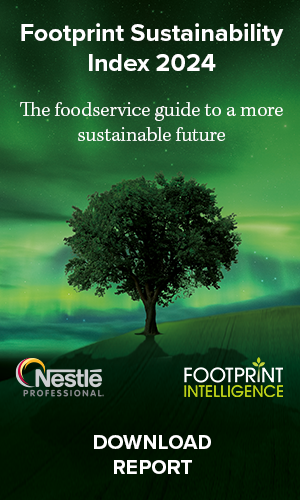A shift to regenerative agriculture underpins the net-zero plans of many food businesses. But does this seductive term have any substance, asks Nick Hughes?
Nestlé is investing CHF1.2bn (£960m) in regenerative agriculture across its supply chain. Compass says 70% of its top five food categories will be sourced from regenerative agriculture by 2030. First Milk will pay a premium to farmers who commit to a regenerative farming plan.
Regenerative is the new buzzword in food and farming circles. But does it have any more substance than that?
Some fear the term risks being co-opted by large corporations to promote farming practices that don’t actually deliver for the environment while adding to the public’s confusion about how their food is produced. In a recent blog, Sustain’s head of farming Vicki Hird wrote: “The hype is huge and there are new promotions, labels, and high-level support being generated. If done well, regenerative approaches could be a force for good; genuinely supporting farmers to do more for climate, nature and the environment. Done badly, it won’t.”
So what is regenerative farming? And how can businesses promoting it as a key element of their net-zero ambitions protect against claims of greenwash?
For Soil Association head of food policy Rob Percival “the shortest, neatest definition of regenerative agriculture is farming which puts more in than it takes out”. Percival explains that regenerative systems have a positive impact on biodiversity as well as adding carbon and fertility to the soil. In essence, they are “the opposite of extractive farming”.
It is these extractive methods historically associated with the supply chains of many multinational companies, including some of those making commitments to regenerative farming, that Hird takes aim at in her blog. “The risky monoculture, high input, cheap output, uniform approaches these giant companies are built on – pushing all the risk down on to the producers and away from shareholders, hedge funds or private owners – are at the heart of their business model and are unlikely to drive the fundamental changes we need,” she wrote.
Efforts to capture those changes neatly in one word, like regenerative, inevitably lead to confusion and discord. A key distinction Percival makes is between regenerative systems and practices. “There are farmers who might do a few bits or pieces of regenerative stuff on the edge of their farm and say that it’s regenerative farming,” he explains. “That differs quite markedly from the farmer who structures his or her entire system around regenerative principles, which in turn brings us much more into the territory of organic and agroecology.”
Defining regenerative
Sue Pritchard, chief executive of the Food, Farming and Countryside Commission and herself an organic livestock farmer, says she favours the term agroecology which “has a stronger definitional base” than regenerative agriculture. Although the Food and Agriculture Organisation of the United Nations (FAO) says agroecology is a diverse concept, it notes that different definitions use and share common elements which it captures in its framework on agroecology.
Regenerative agriculture is less well defined, which is why Pritchard believes “there are important questions to be asked about certain sectors’ ability to greenwash using the regenerative agriculture strapline”. For instance, while fair pricing along the value chain is a fundamental principle of agroecology, Pritchard says her conversations with certain businesses suggest the notion of paying better prices to producers is not part of their definition of regenerative.
There are doubts too over the extent to which the carbon sequestration potential of regenerative agriculture can contribute to a reduction in companies’ greenhouse gas emissions. In a recent programme for BBC Radio 4, farmer and author James Rebanks expressed his excitement about regenerative agriculture which he summarised as “any kind of farming that works with nature to improve the environment”. But when Rebanks spoke with Janet Ranganathan from the World Resources Institute (WRI), she told him that while WRI’s own research shows regenerative agriculture can improve soil health and yield other important environmental benefits “it’s probably unlikely to achieve large scale emissions reductions”.
With scepticism in plentiful supply, businesses promoting their commitment to regenerative farming and its potential to help neutralise emissions will need to work hard to prove such concerns are misplaced. As part of its pledge to achieve net-zero by 2030, Compass UK & Ireland aims to source 70% of its dairy and cheese, fruit and vegetables, pork, beef and chicken from regenerative agriculture by 2030.
Its head of net-zero delivery Carolyn Ball admits regenerative is a “hotly debated term”, which Compass currently defines as “supporting farming and grazing practices that among other benefits look to reverse climate change by rebuilding soil organic matter and restoring degraded soil biodiversity” while in turn “helping to improve the water cycle and carbon drawdown”.
Broad brush definitions are useful communication tools, but establishing and then building consensus around a clear, measurable set of indicators for regenerative farming will surely be key to its acceptance as a credible, net-zero aligned measure.
To this end, Ball reveals Compass is currently in discussions over supporting PhD students to explore “what the definition actually should and does mean in support of the changes that we need it to effect”.
Milk bonus
Compass is far from alone. Earlier this month, dairy cooperative First Milk launched a digital tool to capture regenerative farming plans for each of its farmer members and said it would pay a bonus of 0.5 pence per litre to members who complete plans with the tool using field level data. Through the tool, farmers will detail their current practices and planned changes to reduce carbon emissions and increase carbon sequestration and biodiversity.
First Milk says a commitment to regenerative farming principles is a core part of its net-zero 2040 strategy. “We are convinced that dairy farmers can be part of the solution to the climate crisis by adopting regenerative principles that store carbon in soil for the long term,” says First Milk sustainability director Mark Brooking.
Whether this will be sufficient to win over campaigners remains to be seen. Another criticism of regenerative farming pledges is that outcomes are often too focused on soil carbon levels, which Hird suggests is only one part of a bigger picture that should include “farming with fewer chemicals, more complex rotations, soil health measures, different and diverse plants and far less but more diverse livestock and fisheries”.
A recent paper in the Journal of Science Policy & Governance, which studied regenerative agriculture in the United States, said common regenerative practices like no-till farming, cover cropping, increased crop diversity, integration of livestock, and the reduction or elimination of synthetic pesticides and fertilisers have been shown to be more productive in the long term and more resilient when faced with severe weather events. But the researchers said there is a need for policies to help farmers implement regenerative agriculture principles.
Powerful pledges
In the meantime, major food companies are filling the policy void. PepsiCo has said it wants to “spread regenerative farming practices across seven million acres, approximately equal to its entire agricultural footprint”, saving three million tonnes of greenhouse gas emissions by 2030. Roberta Barbieri, PepsiCo VP of global water and environmental stewardship, noted in a podcast for Future Food earlier this year how difficult it will be to encourage thousands of suppliers to transition. Demonstration farms are already yielding positive results as the company aims to “prove” its regenerative practices are a “win-win”, she explained.
As one of the biggest buyers of agricultural commodities in the world, Nestlé is another supplier that wields huge influence over the practices of thousands of farmers. If the company can make good on its pledge to source 20% of key ingredients through regenerative agricultural methods by 2025, rising to 50% by 2030, it has the power to drive transformational change.
For Nestlé UK & Ireland’s head of sustainability Emma Keller, the term regenerative agriculture is at risk of becoming “the new sustainability” in that “it’s a broad brush term that can mean multiple different things to multiple different people.”
From a Nestlé perspective, Keller says it follows the key principles around better land use management “whether that’s no till farming, reduced chemical inputs, use of organic inputs, agroforestry, planting hedgerows and then particularly in livestock farming where there are different models of grazing that can be used to allow grasslands to recover faster”.
She adds: “We know that the food sector is a major contributor to global emissions but has a unique opportunity to be part of the solution and we need to ensure a just transition to this new way of producing and consuming food.”
Nestlé is looking at implementing approaches at a landscape scale using a model called LENs (landscape enterprise networks) where different stakeholders in a certain landscape who rely on that land come together to map out and implement different solutions. “It may be that we’re sourcing ingredients from a particular landscape,” explains Keller. “There may be water companies present; there may be other economic users; but how do we come together with a shared interest in restoring that landscape so that it is more resilient and regenerative and becomes a carbon sink? We can then create a proposition that we can co-invest in to implement those solutions for the long-term.”
The very fact that large corporations are talking the language of regenerative agriculture feels like progress in itself. Percival says: “The buzz around regenerative still feels like it’s helpful at the moment and the fact it’s an open term means it’s not excluding anyone and is probably shifting the conversation in the right direction.” He cautions, however, “the risks are that commitments are ill-defined and can pretty much add up to greenwashing”.
Regenerative is a seductive term for food businesses looking to articulate the way in which they are treading more lightly on the planet. But without proper transparency and accountability over what it means in practice, regenerative agriculture risks breeding as much cynicism as it does success.














